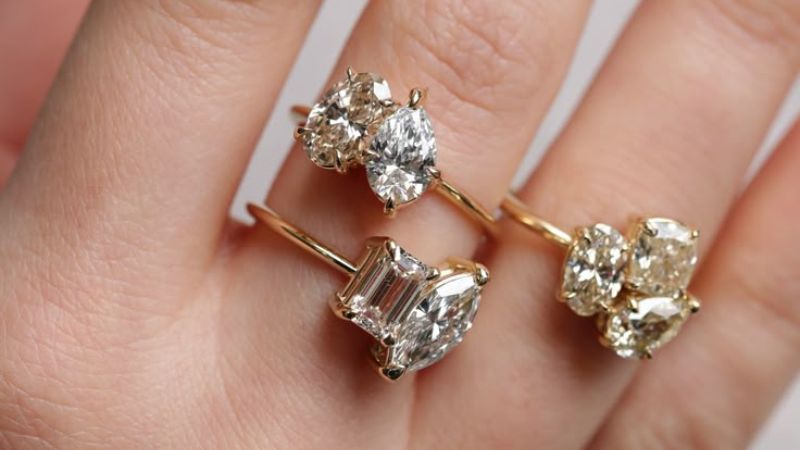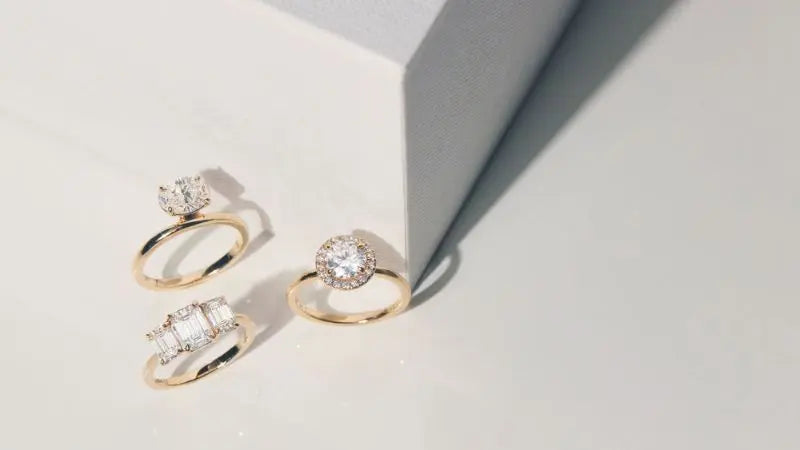Up To $2,500 OFF at checkout - Ends Dec 12
Free 30-day Returns | Lifetime Warranty
This comprehensive guide will walk you through everything you need to know about tension setting diamond ring.
1. Introduction
A tension setting engagement ring is a bold, modern choice that blends artistry with engineering. Unlike prong or bezel settings, which rely on visible metal for security, a tension setting uses precision-crafted compression.
This creates a floating effect, enhancing the stone’s brilliance while giving the ring a sleek, contemporary look. This guide explores everything you need to know about tension setting diamond rings.
2. What Is a Tension Setting Engagement Ring?
A tension setting engagement ring holds the gemstone in place using metal pressure rather than prongs or bezels.
The band is meticulously engineered to grip the stone, creating the illusion of it being suspended between the ring’s open ends. This cutting-edge design delivers a striking, minimalist aesthetic.

The solitaire Skyler oval lab diamond ring
Unlike traditional settings, a tension ring demands expert craftsmanship and advanced technology. Each ring is custom-made to fit the precise measurements of the gemstone, making every piece a unique work of art.
3. How It Works
Jewelers precisely measure the gemstone and cut microscopic grooves into the band’s opening to hold the stone’s edges. The metal is then widened, the gem placed inside, and the band is allowed to close, exerting calculated pressure to keep the stone secure.

The sketch of a tension setting diamond ring
4. Advantages of a Tension Setting Diamond Ring
4.1. Sleek, Modern Design
Tension rings offer a minimalist, futuristic aesthetic. Their floating effect creates a captivating, high-impact look that stands out from traditional engagement rings.

The round-cut dainty diamond tension rings
4.2. Enhanced Diamond Brilliance
With minimal metal obstruction, a tension setting allows maximum light exposure. This boosts the diamond’s sparkle, making it appear more brilliant than in conventional settings.

The open bezel set diamond solitaire tension setting ring
4.3. Exceptional Security
Despite its delicate appearance, a well-crafted tension setting is highly secure. The metal applies precise pressure to hold the stone firmly in place. Reputable jewelers rigorously test these rings for durability.

The square stone tension setting engagement ring
4.4. Low Maintenance
With no prongs or intricate metalwork, a tension setting engagement ring is easier to clean. The open design reduces crevices where dirt can accumulate, making maintenance simple and hassle-free.
5. Drawbacks of a Tension Engagement Ring Setting
Tension-set rings offer beauty and innovation, but they come with challenges.
5.1. Limited Resizing Options
Resizing a tension ring is difficult. The band is engineered to hold the gemstone under precise pressure, and altering it can weaken the structure.
5.2. Fragility and Risk of Damage
Tension settings apply significant force to the gemstone. Only durable stones like diamonds, sapphires, and rubies can withstand this pressure. Softer gems, such as opals and emeralds, risk chipping or cracking.
5.3. Higher Cost
These rings require expert craftsmanship and precision engineering, increasing their cost compared to traditional settings. Custom designs add to the expense.
6. Choosing the Right Diamond for a Tension Setting
The constant pressure of a tension setting demands a durable, high-quality gemstone.
6.1. Diamond Hardness
Diamonds (rated 10 on the Mohs scale) are ideal, along with sapphires and rubies. Avoid softer stones, as they are more prone to damage.

The round brilliant diamond engagement ring
6.2. Cut and Shape
Round brilliant and princess cuts maximize sparkle, while oval, pear, and marquise cuts offer a distinctive look.

The contemporary tension set pave diamond engagement ring
6.3. Clarity and Color
Tension settings expose much of the diamond. Choose a high-clarity stone to minimize visible inclusions or blemishes.
7. Caring for a Tension-Set Diamond Ring
Proper care preserves your ring’s beauty and structural integrity.
7.1. Regular Cleaning
Use warm water, mild soap, and a soft toothbrush. Avoid abrasive cleaners and harsh chemicals.
7.2. Professional Inspections
Have a jeweler check the setting periodically to ensure the stone remains secure.
7.3. Safe Storage
Store your ring in a padded jewelry box or soft pouch to prevent scratches.
7.4. Avoid High-Impact Activities
Remove your ring before engaging in heavy labor, sports, or activities that could subject it to excessive force.
8. Customizing a Tension Setting Engagement Ring
One of the best features of a tension setting ring is its customizability. Here’s how to make it unique:
8.1. Metal Choices
Choose from platinum, white gold, yellow gold, or rose gold. Platinum offers maximum durability, while gold provides a classic, warm aesthetic.
8.2. Unique Band Designs
Enhance the ring with twisted bands, asymmetrical shapes, or mixed-metal elements for a bold, modern look.

The diamond tension set engagement ring with channel setting band
8.3. Accent Stones
Most tension settings emphasize a single stone, but side stones or pavé diamonds can add extra brilliance.
9. Is a Tension Setting Right for You?
Tension settings suit those who love contemporary, innovative designs. They offer a unique alternative to traditional prong settings but require careful maintenance.
If you appreciate clean lines, minimal metal, and a striking floating effect, a tension setting could be the perfect choice.
10. Conclusion
A tension setting ring is a masterpiece of engineering and design, showcasing a diamond’s brilliance in a modern, elegant way.
If you’re considering this style, choose a jeweler skilled in crafting tension settings. With the right diamond and proper care, your ring will remain a timeless symbol of love and innovation.




